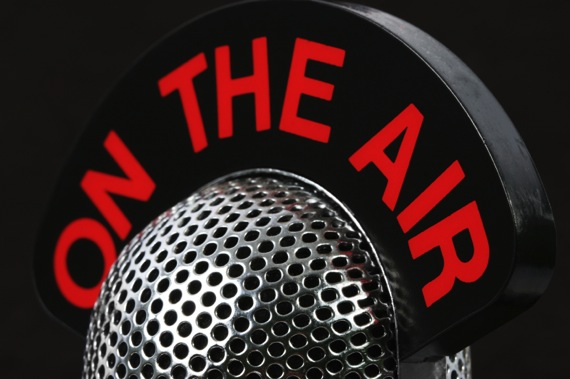On February 2nd, 2017, Thursday morning at 10 am Central time, I will be on ONE RADIO NETWORK (see schedule here). On this talk show I will present my views about the causes of migraines. The talk show invites advance emailed-in questions to email@oneradionetwork.com, as well as live call-ins during the show at: 888.663.6386. Here is the page where you can listen to the archived recording on the Internet (one hour talk show). If you are in Austin, Texas, you can listen on the radio.
Migraine Brain as a Survival Advantage
For a while we have known that the human body contains approximately 20 thousand genes, although this number seems to be a moving target as technology improves. The latest studies have reduced it to 19 thousand. From the 19 thousand, so far 1254 genes have been associated with migraines. Such a huge number of genes – associated with a condition that plagues nearly 30% of the population – begs for an explanation.
Could it be that migraine at one time in human history provided a survival advantage? A benefit that helped those endowed with this set of genes to survive? The answer to this question must be “yes” because the migraine-brain has survived in the population for so long. It has not been bred out of human populations over the millennia of our evolution. Health conditions disadvantageous for survival normally get deleted from our genome.
The question “why migraine hurts” has a simple answer based on this theory: pluck a group of people with a special adaptation from its natural habitat and place it into a different environment, and what was an advantage suddenly becomes a disadvantage. There are many examples for this in nature.
Greenland Inuit, Canadian Inuit and the Native American populations all have glucose (simple sugar into which all carbohydrates, including fruits and vegetables, grains, nuts, seeds, and some percent of proteins convert) intolerance genes. Fructose (a sweet substance that is approximately half of table sugar; found in fruits, vegetables, and syrups like honey, maple syrup, and of course high fructose corn syrup) can also be problematic. Many of us are born without the necessary enzymes to absorb fructose. The inability to digest sugar can cause diarrhea. In medical parlance, this is called “malabsorption” but the question remains: if so many people are born without the ability to absorb sugar, would that be considered a “malabsorption” or is sugar absorption an adaptation that occurred later in time? I am not the first one to ask this question.
Now returning to migraine: it is found in at least as large fraction of the population as it is for the inability to absorb sugars, like glucose or fructose. The set of adaptations for the more sensitized brain to danger (that migraineurs today still possess) at one time may have been present in all of our predecessors. Some percent of the ancient population likely never lost this highly sensitized brain adaptation because in the ancient environment it would have provided a survival benefit. However, in our modern life, the highly sensitized brain has become a painful burden, whereas a large percent of the population adapted to modern life, reduced their brain sensitivity and they feel no pain. This is likely similar to how the majority of the population adapted to digest and absorb sugar; only a minority retained their inability to do so, and they still experience painful health conditions as a result.
The cause of migraines is not the pain—the pain is one of many symptoms. Just like medicating children to be able to eat an ice cream makes little sense, so is medicating migraine pain by blocking certain brain functions makes little sense. That is the only thing that the medicines are able to do and they are dished out to migraineurs like candy. Here are three of the most common (and most dangerous) medications given to migraineurs as “preventive” and what they block: Propranolol (blocks cardiac and neuronal voltage-gated sodium channels), Topamax (blocks voltage gated calcium and sodium channels), Amitriptyline (blocks or initiates many channels out of sync, causing major heart damage and sometimes death). Would we put ourselves at these types of risks in order to be able to eat a piece of sugar if we lacked the enzymes to digest them? I think the real problem is the lack of understanding of the true nature of migraines.
Migraines and Salt
Migraine starts with prodromes that are signals of an impending migraine. These prodromes precede a cascade of events that lead to the pain, which starts with the initiation of an alarm status that leads to fight-or-flight from danger. A migraineur can easily be triggered into a migraine by noise, odor, a specific light intensity, and even taste that is above or below the norm. Migraineurs have hyper sensory organ sensitivities (1), more sensory neuronal connections than the norm (2), and this is how perfume can trigger a migraine because that scent is above the norm. A migraineur will start a migraine unless voltage is re-established. Why voltage? Migraineurs use more voltage (3, 4) as a result of the more sensitive sensory organs. Voltage is generated by the sodium/potassium pumps that are located in cell membranes, facilitating voltage differential exchanges between the inside and the outside of the cell. Since more voltage use requires more salt, migraineurs need to consume more salt (sodium chloride). Migraineurs tend to pass more sodium in their urine as a result (5).
The modern Western diet is forever reducing its salt recommendation for the general population, ignoring that a large percent of that population needs more salt than what is recommended. In general, I found that migraineurs need approximately 50% more salt in their diet than non-migraineurs.
Migraines and Sugar
Another factor is sugar. While there is no academic research on migraineurs lacking enzyme to absorb fructose or that they are genetically lacking glucose absorption (although there are many research papers hinting at their possibilities–here is a review of some), it seems, based on the several thousand migraineurs I studied, that migraineurs are either sugar intolerant or are hyper sensitive to sugar—and all forms of carbohydrates. Indeed, migraineurs usually become insulin resistant. It would be quite educational to provide genetic testing to all migraineurs to find out what may drive their intense reaction to carbohydrates. Most migraineurs can completely prevent all migraines by completely avoiding refined carbohydrates, reducing complex carbohydrates to near the low carbs high fat (LCHF) diet levels, and increasing dietary animal fats (not oils).
Myelin is made from fat and cholesterol; it is the white matter in the brain, responsible for insulating the neurons’ axons, the parts that transmit voltage. Since migraineurs transmit voltage more often, their myelin is more likely to get damaged. Glucose seems to aggravate nerves in general in all central nervous systems conditions. The ketogenic (high fat, very low carbohydrate) diet may be ideal for migraineurs since it appears to repair the myelin damage glucose causes. Myelin can be replenished by eating a proper, high in natural fat (not man-made oils) diet and by ensuring that a migraineur retains a healthy insulin response. As expected, migraine is highly correlated with the incidence of insulin resistance (6-8), diabetes mellitus (7), obesity (9), and cardiovascular disease (10).
If migraine were a true disease, dietary changes would not be able to change the brain response in a way that all migraines become preventable and abortable without medications. Since they can be prevented and aborted with the proper migraine-brain diet (an ancient type diet that is void of simple sugars and complex carbohydrates in excess), it follows that migraine is an unintended consequence of the modern Western diet and it is not a disease.
Sources:
- Schwedt TJ (2013) Multisensory Integration in Migraine. Curr Opin Neurol:248-253.
- Tso AR, Trujillo A, Guo CC, Goadsby PJ, & Seeley WW (2015) The anterior insula shows heightened interictal intrinsic connectivity in migraine without aura. Neurology:1043-1050.
- Liu H, et al. (2015) Resting state brain activity in patients with migraine: a magnetoencephalography study. in The Journal of headache and Pain, pp 16-42.
- Tessitore A, et al. (2015) Abnormal Connectivity Within Executive Resting-State Network in Migraine With Aura. Headache 55(6):794-805.
- Campbell DA, Tonks EM, & Hay KM (1951) An Investigation of the Salt and Water Balance in Migraine. British Medical Journal:1424-1429.
- Bhoi S, Kalita J, & Misra U (2012) Metabolic syndrome and insulin resistance in migraine. The Journal of Headache and Pain 13(4):321-326.
- Guldiken B, et al. (2009) Migraine in Metabolic Syndrome. The Neurologist 15(2):55-58.
- Sachdev A & Marmura MJ (2012) Metabolic Syndrome and Migraine. Frontiers in Neurology 3:161.
- Bigal ME, Liberman JN, & Lipton RB (2006) Obesity and migraine: a population study. Neurology 66.
- Tana C, et al. (2013) New insights into the cardiovascular risk of migraine and the role of white matter hyperintensities: is gold all that glitters? The Journal of Headache and Pain 14(1):9.
We need your help.
Hormones Matter needs funding now. Our research funding was cut recently and because of our commitment to independent health research and journalism unbiased by commercial interests, we allow minimal advertising on the site. That means all funding must come from you, our readers. Don’t let Hormones Matter die.










